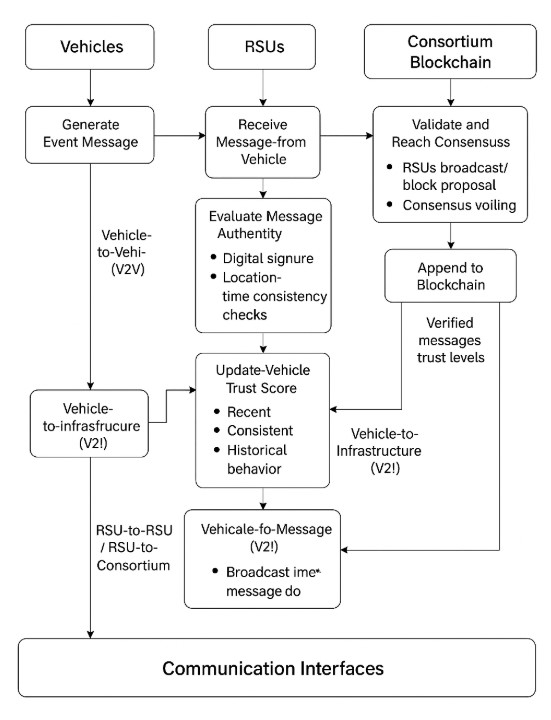A Lightweight Blockchain-Enabled Trust Management Model for Secure Vehicular Communication
Keywords:
Trust Management, Blockchain, Consortium Network, Proof-of-AuthorityAbstract
Vehicular Ad Hoc Networks (VANETs) are emerging as a pivotal component in intelligent transportation systems, offering safety-critical and comfort-related information to drivers and passengers. The effectiveness of VANETs relies on the timely exchange of messages between vehicles and roadside units (RSUs), where trustworthiness of shared data is paramount. Traditional centralized trust models, though efficient in information validation, suffer from single points of failure, limited scalability, and vulnerability to insider threats. This has driven a paradigm shift toward decentralized architectures, with blockchain technology standing out due to its immutable, transparent, and distributed nature. This study presents a comprehensive review of existing centralized and decentralized trust management models in VANETs, analyzing their methodologies, strengths, and limitations. By examining trust metrics, validation schemes, and message verification strategies across the literature, it identifies critical gaps in scalability, response time, and resistance to malicious behavior. Addressing these limitations, we propose a novel blockchain-based trust model named CB-RTM (Consortium Blockchain for RSU-Assisted Trust Management), an intelligent framework designed to ensure secure, verifiable, and real-time dissemination of safety messages in VANETs. The CB-RTM model integrates consortium blockchain with RSU-based validation and a Proof-of-Authority (PoA) consensus mechanism to filter and authenticate event messages using location certificates and trust scores. Unlike existing approaches, the model localizes trust updates and block propagation to geographically bounded regions, enhancing scalability and latency performance. Experimental evaluation demonstrates that the proposed CB-RTM outperforms state-of-the-art models across key metrics. The model achieves a trust accuracy of 96.2%, latency of 0.42 seconds, and throughput of 245 messages per second, while maintaining a manageable communication overhead of 11.2%. These results confirm that CB-RTM is a robust, scalable, and efficient solution for trust management in real-time VANET environments
References
L. M. Eslam Farsimadan, “A Review on Security Challenges in V2X Communications Technology for VANETs,” IEEE A, 2025, [Online]. Available: https://ui.adsabs.harvard.edu/abs/2025IEEEA..1331069F/abstract
K. R. Esti Rahmawati Agustina, “A Systematic Literature Review on Privacy Preservation in VANETs: Trends, Challenges, and Future Directions,” IEEE Access, vol. 99, 2025, doi: 10.1109/ACCESS.2025.3570491.
A. Heidari, M. A. J. Jamali, and N. J. Navimipour, “An Innovative Performance Assessment Method for Increasing the Efficiency of AODV Routing Protocol in VANETs Through Colored Timed Petri Nets,” Concurr. Comput. Pract. Exp., vol. 37, no. 3, p. e8349, Feb. 2025, doi: 10.1002/CPE.8349;REQUESTEDJOURNAL:JOURNAL:15320634;WGROUP:STRING:PUBLICATION.
A. T. A. Walid El-Shafai, “AI-Driven Ensemble Classifier for Jamming Attack Detection in VANETs to Enhance Security in Smart Cities,” IEEE Access, vol. 99, 2025, doi: 10.1109/ACCESS.2025.3552544.
Q. Tao, X. Cui, H. Ding, Z. Shen, and Y. Li, “ELSP-MA: An Efficient Lightweight and Security-enhanced Privacy-preserving Message Authentication Scheme for VANETs,” IEEE Trans. Veh. Technol., 2025, doi: 10.1109/TVT.2025.3571380.
F. P. Xiaoliang Wang, Peng Zeng, Guikai Liu, Kuan-Ching Li, Yuzhen Liu, Biao Hu, “A privacy-preserving certificate-less aggregate signature scheme with detectable invalid signatures for VANETs,” J. Inf. Secur. Appl., vol. 89, p. 104001, 2025, doi: https://doi.org/10.1016/j.jisa.2025.104001.
A. Z. J. Shahparian, S.H. Erfani, “A secure and efficient authentication and key agreement protocol in blockchain-enabled VANETs,” Comput. Electr. Eng., vol. 122, p. 109947, 2025, doi: https://doi.org/10.1016/j.compeleceng.2024.109947.
C. S. Huimin Li, “A certificateless aggregate signature scheme for VANETs with privacy protection properties,” PLoS One, vol. 20, no. 2, p. 2, 2025, doi: 10.1371/journal.pone.0317047.
C. Cai, X. Yuan, and C. Wang, “Towards trustworthy and private keyword search in encrypted decentralized storage,” IEEE Int. Conf. Commun., vol. 0, Jul. 2017, doi: 10.1109/ICC.2017.7996810.
A. Kosba, A. Miller, E. Shi, Z. Wen, and C. Papamanthou, “Hawk: The Blockchain Model of Cryptography and Privacy-Preserving Smart Contracts,” Proc. - 2016 IEEE Symp. Secur. Privacy, SP 2016, pp. 839–858, Aug. 2016, doi: 10.1109/SP.2016.55.
W. J. & H. L. Qiuling Yue, “A lightweight certificateless aggregate signature scheme without pairing for VANETs,” Sci. Rep., vol. 15, no. 23663, 2025, doi: https://doi.org/10.1038/s41598-025-08656-1.
H. Hasrouny, A. Samhat, C. Bassil, and A. Laouiti, “Trust model for group leader selection in VANET,” Int. J. Digit. Inf. Wirel. Commun., vol. 8, no. 2, pp. 139–143, 2018, doi: 10.17781/P002421.
U. Javaid, M. N. Aman, and B. Sikdar, “DrivMan: Driving trust management and data sharing in VANETs with blockchain and smart contracts,” IEEE Veh. Technol. Conf., vol. 2019-April, Apr. 2019, doi: 10.1109/VTCSPRING.2019.8746499.
S. C. M. Saeid HaghighiFard, “Hierarchical Federated Learning in Multi-hop Cluster-Based VANETs,” arXiv:2401.10361, 2024, doi: https://doi.org/10.48550/arXiv.2401.10361.
H. Zhang, Jing and Wang, Xin and Cui, Jie and Li, Ru and Zhong, “A Decentralized Threshold Credential Management With Fine-Grained Authentication for VANETs,” IEEE Trans. Inf. Forensics Secur., 2025, [Online]. Available: https://ieeexplore.ieee.org/document/11027789
P. Vinayasree and A. M. Reddy, “A Reliable and Secure Permissioned Blockchain-Assisted Data Transfer Mechanism in Healthcare-Based Cyber-Physical Systems,” Concurr. Comput. Pract. Exp., vol. 37, no. 3, p. e8378, Feb. 2025, doi: 10.1002/CPE.8378.
A. Deng, Q. Ren, Y. Wu, H. Lei, and B. Chen, “Proof of Finalization: A Self-Fulfilling Function of Blockchain.,” IEEE Trans. Inf. Forensics Secur., vol. 19, pp. 8052–8065, 2024, doi: 10.1109/TIFS.2024.3451355.
C. Chukwuocha, P. Thulasiraman, and R. K. Thulasiram, “Trust and scalable blockchain-based message exchanging scheme on VANET,” Peer-to-Peer Netw. Appl., vol. 14, no. 5, pp. 3092–3109, Sep. 2021, doi: 10.1007/S12083-021-01164-9/METRICS.
G. Q. Yingqing Wang, Yanhua Liang, Yue Huang, “VECLLF: A vehicle-edge collaborative lifelong learning framework for anomaly detection in VANETs,” Comput. Networks, vol. 265, p. 111328, 2025, doi: https://doi.org/10.1016/j.comnet.2025.111328.
K. R. Dhawale, P. Dubey, A. R. P. Bhagat, K. R. Dhawale, P. Dubey, and A. R. P. Bhagat, “Blockchain Enhanced VANETs for Secure, Resilient, and Efficient Urban Mobility,” https://services.igi-global.com/resolvedoi/resolve.aspx?doi=10.4018/979-8-3373-0265-2.ch013, pp. 247–270, Jan. 1AD, doi: 10.4018/979-8-3373-0265-2.CH013.

Downloads
Published
How to Cite
Issue
Section
License
Copyright (c) 2025 50sea

This work is licensed under a Creative Commons Attribution 4.0 International License.




















